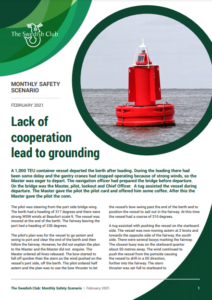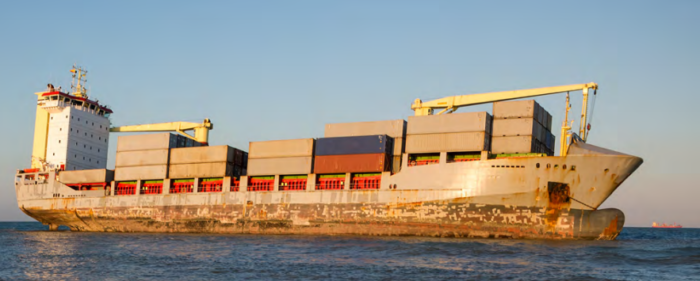In February’s Monthly Safety Scenario, the Swedish Club focuses on an incident concerning a container vessel that ran aground. The vessel’s grounding was the result of miscommunication issued between the Master and the Pilot.
The Incident
A 1,000 TEU container vessel departed the berth after loading. The master of the vessel was eager to depart, following a delay during the loading operation, as the cranes had stopped due to strong winds. In the meantime, the navigation officer had prepared the bridge before departure.
Located on the bridge were the Master, pilot, lookout and Chief Officer. A tug assisted the vessel during departure. The Master gave the pilot the pilot card and offered him some coffee. After this the Master gave the pilot the conn.
The pilot was steering from the port side bridge wing. The berth had a heading of 317 degrees and there were strong WSW winds at Beaufort scale 9. The vessel was moored at the end of the berth. The fairway leaving the port had a heading of 230 degrees.
According to the pilot’s plan, the vessel would go astern and swing to port and clear the end of the berth and then follow the fairway. Yet, the pilot hadn’t discussed their plan with the master and the master did not enquire. This led to the Master ordering all lines released.
Following, the bow started to fall off quicker than the stern as the wind pushed on the vessel’s port side, off the berth. The pilot ordered half astern and the plan was to use the bow thruster to let
the vessel’s bow swing past the end of the berth and to position the vessel to sail out in the fairway. At this time the vessel had a course of 310 degrees.
[smlsubform prepend=”GET THE SAFETY4SEA IN YOUR INBOX!” showname=false emailtxt=”” emailholder=”Enter your email address” showsubmit=true submittxt=”Submit” jsthanks=false thankyou=”Thank you for subscribing to our mailing list”]
A tug assisted with pushing the vessel on the starboard side. The vessel was now moving astern at 2 knots and towards the opposite side of the fairway, the south side. There were several buoys marking the fairway. The closest buoy was on the starboard quarter about 50 metres away.
The wind continued to push the vessel from the portside causing the vessel to drift in a SE direction, further into the fairway. The stern thruster was set full to starboard to assist the vessel in turning to port. The vessel started to slowly come around with a heading of 291 degrees, butwas still drifting SE, towards the buoy.
The Second Officer on the stern warned the Chief Officer over the UHF that the buoy was only 30 metres away on the starboard quarter. The vessel now had a heading of 320 degrees which presented a 90 degree angle towards the fairway.
The Swedish Club notes that
The Chief Officer informed the pilot and Master but neither of them acknowledged or took any action.
In addition, the Second Officer then informed the Chief Officer that the buoy was only 10 metres away and the pilot ordered half ahead on the engines and for some reason the stern thruster was stopped. At the same time, the pilot received a job-related mobile phone call which he answered. The vessel continued its movement astern and hit the buoy on the starboard quarter.
The entire buoy was dragged underneath the vessel and damaged the propeller, rudder and rudder stock.
The damage caused the vessel to lose its steering and the Master was forced to stop the main engine. This caused the vessel to start drifting even quicker in a SE direction towards shallow waters,
… the Club highlights.
The pilot suggested that the anchor be dropped. This was delayed as the Second Officer had to cross from the stern to the bow of the vessel to reach the port anchor. When he reached the bow the bosun tried to drop the anchor, but it became entangled and it took a minute before it was released. At the same time the vessel ran aground.
Concluding, you may learn more by clicking herebelow































































